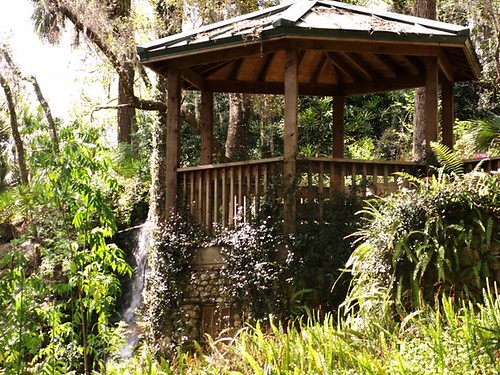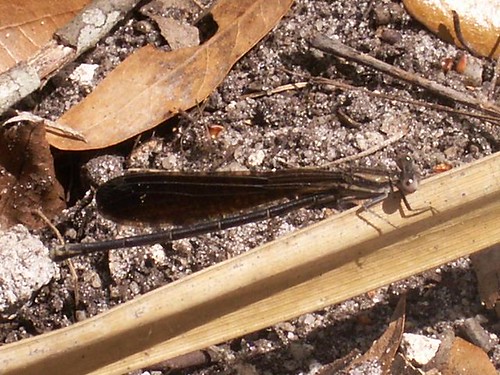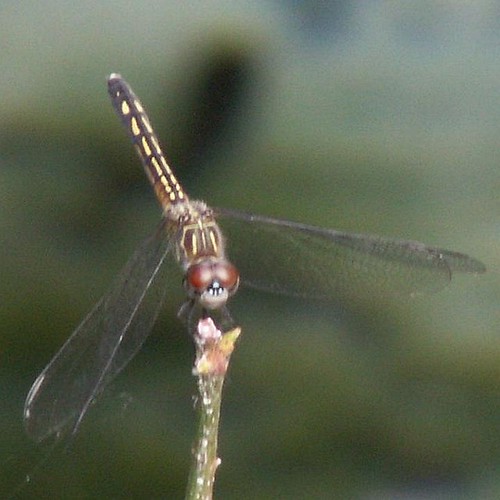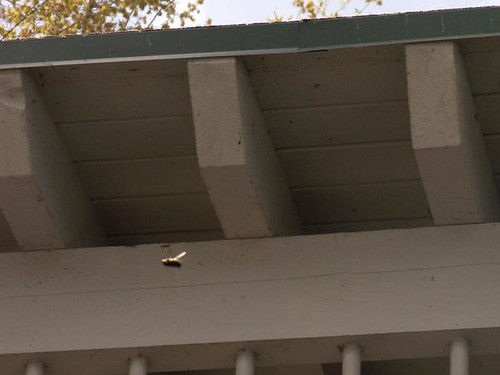Rainbow Springs State Park, Part 7 of 7

On March 13, 2006, Mary and I visited the Rainbow Springs State Park, which features the headsprings of the Rainbow River. These waters run to the Withlacoochie River, through Lake Rousseau, and finally into the Gulf of Mexico.
The park's 1,595 acres contain at least 11 distinct, natural communities: mesic flatwoods, sandhills, scrubby flatwoods, sinkholes, upland mixed forests, basin swamps, depression marshes, floodplain swamps, and hydric hammocks.
Above, Rainbow Falls cascades just to the left of an observation gazebo....

The Variable Dancer damselfly (Argia fumipennis) ranges through northern and central Florida, according to the National Audubon Society Field Guide to Florida. This little one had come to rest on the ground beside a magnolia.

I'm guessing this is a female Blue Dasher (Pachydiplax longipennis), based on photo "dash04" at Larvalbug.com and photos at Bugguide.Net.
The position this one is holding is called obelisking. "Dragonflies display a wide range of behavior in order to regulate their body temperatures," writes William Cochran in the entomology department of Colorado State University. "The thorax of dragonflies is insulated with air sacs to aid in thermoregulation. Some dragonflies can change their posture in order to thermo regulate. When too hot they can elevate their thorax and abdomen to a vertical position, called obelisking, decreasing the amount of solar radiation received by the dragonfly. Obelisking is abandoned when heat levels decrease in the insect. " (Cochran, "Biological and Ecological influences on the Behavior of Dragonflies" (.pdf file))

I was sitting at the park's outdoor food pavilion when a bumblebee started zipping about. I set my camera to its fastest shutter speed (1/1000-second), enlarged my aperture to get enough light (f/4.5), and then started chasing the bee through my viewfinder. I've brightened the shot above a bit and cropped it.

Except for cropping and compression this is as is out of the camera.
Back at home, we've been seeing the Return of the Pretty Bugs. A few days ago on my post office walk I spotted Buckeye butterflies in the front yard, a Giant Leopard Moth outside the supermarket, and a Polyphemus Moth outside the bank. (Half the fun is diving for the field guides or onto Bugguide.Net to do species ID.) Photos of those will come next. The saddlebag dragonflies are out again, too, though so far they're too zippy for me to catch on pixel.
Thanks to my friend Barbara, who identified this plant in Part 3 as a "shrimp plant" (Justicia brandegeana, Family Acanthaceae) and writes, "They are unusual in form and delightful! Just pick a sunny, some shade, sandy, well-drained spot. Butterflies love them and when they grow high enough, so do the hummingbirds. When the plant is in its native habitat, it is real dark 'pink', the pink is the bracts. The white is the flower. You seen them selling the yellow ones now."











1 Comments:
Hi Elissa, I see we have both posted about a state park. Hope all is well with you!
Post a Comment
<< Home